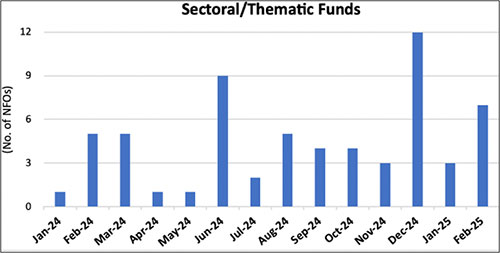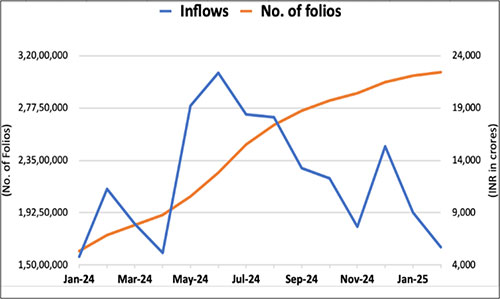What Are Sectoral Mutual Funds? Should You Invest in Them in 2025?
Rounaq Neroy
Apr 04, 2025 / Reading Time: Approx. 10 mins
Listen to What Are Sectoral Mutual Funds? Should You Invest in Them in 2025?
00:00
00:00
According to SEBI, Sectoral/Thematic Funds are open-ended equity mutual funds that invest a minimum of 80% of their assets in a particular sector or theme.
Each scheme must clearly specify the sector/theme it will focus on for investments. These schemes also have the flexibility to invest across the market cap range, viz., large-cap, mid-cap, and small-cap stocks, without restriction.
The primary difference between Sectoral and Thematic Funds lies in their scope of investment.
Sectoral Funds mainly invest in companies from one particular sector, whereas Thematic Funds are broader and invest in companies across different sectors that are linked by a specific overarching theme.
For instance, a healthcare sector fund might focus on hospitals, pharmaceutical companies, and medical device manufacturers.
[Read: Are Sectoral and Thematic Funds Worth Adding to Your Portfolio in 2025?]
On the other hand, a Thematic Mutual Fund emphasising on green energy might focus on companies involved in wind energy, solar power, and Electric Vehicles (EVs).
There are several types of Sectoral Funds currently available in India, viz., Auto Fund, Bank Fund, IT Fund, Healthcare Fund, Pharma Fund, FMCG Fund, and so on.
In recent years, sectors/themes such as green energy, infrastructure, technology, and healthcare have experienced rapid growth, fueled by technological advancements, favourable government policies, and rising global demand.
Sectoral and Thematic Funds aligned with these thriving industries have the potential to generate strong returns.
Therefore, it is hardly a surprise that these funds are capturing keen investor interest.
However, do note that the recent import tariff hike at 25% announced by the 47th U.S. President Donald Trump is expected to impact several key sectors in India. Industries with a significant share of the market in the U.S. may face increased costs and an inability to compete in the U.S market.
Some of the most impacted industries could include (but may not be limited to) textiles and apparel, jewellery and gemstones, pharmaceuticals, IT services, automotive parts, and electronics. Indian steel and aluminum exports could also see a decline if additional duties are imposed, impacting domestic production and profitability for Indian metal producers.
Overall, variable tariffs may create a scenario where India rethinks its export strategies businesses could use efforts to market to multiple export markets and diversify supply chains, and/or possibly ask for government assistance to reduce any potential negative impacts on the Indian economy.
The calendar year 2024, despite being marked by turbulence in the Indian equity market, saw around 52 New Fund Offers (NFOs) being launched in the Sectoral/Thematic Mutual Funds category, collectively contributing to a substantial Rs 79,109 crore.
Graph 1: No. of NFOs Launched Under the Sectoral/Thematic Mutual Funds Category 2024-25
 The securities quoted are for illustration only and are not recommendatory.
The securities quoted are for illustration only and are not recommendatory.
Past performance is not an indicator of future returns
Data as of April 02, 2025
(Source: AMFI, data collated by PersonalFN)
As seen in Graph 1, there is a noticeable spike in June 2024 and December 2024, with 9 and 12 NFOs being launched, respectively.
The year 2025 seems likely to continue in the same vein, with 7 new NFOs being launched in February 2025 after a slight dip in the previous month.
As seen in Graph 2, there is a steady rise in the number of folios, reflecting growing investor participation and interest, peaking at around 3,06,56,958 in February 2025.
Graph 2: Trend of Inflows and Folio Growth under Sectoral/Thematic Mutual Funds Category
 The securities quoted are for illustration only and are not recommendatory.
The securities quoted are for illustration only and are not recommendatory.
Past performance is not an indicator of future returns
Data as of April 02, 2025
(Source: ACE MF, data collated by PersonalFN)
Inflows, on the other hand, display significant volatility with a sharp increase from March to May and June 2024, a decline from August, followed by a spike in December 2024.
The noticeable rise in the number of folios or mutual fund accounts reveals that investors are increasingly taking calculated risks in the pursuit of higher returns (than some of the traditional investment avenues).
The rise can also be attributed to mutual fund houses launching new fund offers. Investors are perhaps drawn to the prospect of tapping into high-growth or emerging sectors with a low NAV of Rs 10 only. However, it should be noted that NAV does not indicate the future prospects of a mutual fund scheme.
The consistent growth in folios can also be a result of past investment success observed in Sectoral and Thematic Funds, owing to factors such as a capex push and reform initiatives like 'Make in India'.
Let's take a look at how the sub-categories of Sectoral/Thematic Funds have performed historically:
Table: Performance of Sub-Categories Under Sectoral/Thematic Mutual Funds
| Equity Mutual Fund Category |
Absolute % |
CAGR % |
| 1 Year |
3 Years |
5 Years |
7 Years |
10 Years |
| Infrastructure |
47.67 |
30.27 |
28.48 |
18.52 |
17.63 |
| Pharma |
35.57 |
19.51 |
28.00 |
19.74 |
15.49 |
| Technology |
21.65 |
14.19 |
27.81 |
24.94 |
18.89 |
| Energy & Power |
30.46 |
24.32 |
27.59 |
17.53 |
18.26 |
| Thematic Funds |
29.91 |
20.62 |
23.80 |
15.60 |
15.13 |
| FMCG |
25.63 |
20.65 |
21.15 |
16.40 |
16.41 |
| BFSI |
18.43 |
16.05 |
15.12 |
12.75 |
13.70 |
The securities quoted are for illustration only and are not recommendatory.
Past performance is not an indicator of future returns
Data as of April 02, 2025
(Source: ACE MF, data collated by PersonalFN)
As you can see from Table 1, the Infrastructure category has delivered an impressive 47.67% growth over the past year. The Pharma sector has also demonstrated strong short-term gains (35.57%) alongside a commendable 5-year CAGR of 28.00%. While the Technology sector's 1-year returns are slightly lower at 21.65%, it has performed well over medium-to-long term horizons.
Categories such as FMCG and BFSI have delivered relatively moderate yet stable returns compared to the high-growth sectors, highlighting the risk-reward dynamics within these funds.
Who Should Invest in Sectoral Mutual Funds?
As the investment universe for Sectoral/Thematic Funds is limited to a particular sector/theme, the portfolio tends to be highly concentrated.
When stocks of a particular sector/theme perform well, the schemes focusing on it can deliver exceptionally high returns.
However, the concentrated nature also increases the downside risk during uncertain or volatile market conditions.
If the chosen sector or theme falls out of favour, the lack of diversification can lead to significant losses for investors.
Understand that no sector or theme can consistently deliver multibagger returns year after year. Each one undergoes cycles of outperformance and underperformance, influenced by factors such as government policies, demand shifts, and other growth drivers.
By the time an investor decides to invest in a Sectoral/Thematic Fund, the underlying trend may have already peaked, leaving little room for further gains.
Moreover, if the sector or theme falls out of favour after a period of underperformance, recovery may take time. Unlike diversified equity funds, sectoral or thematic fund managers have limited flexibility to reallocate investments away from underperforming sectors or themes.
Thus, investing in Sectoral/Thematic Funds simply because an NFO has been launched or because historical returns seem appealing can be a fatal mistake. Remember that past returns are in no way indicative of future returns.
These funds are best suited for experienced investors who can assess and evaluate the growth prospects, valuations, and risks associated with a specific sector or theme. They should also have the ability to make timely decisions on when to enter or exit these funds, as timing is critical to maximising gains and minimising losses.
Given the current market volatility, investors should ideally avoid Sectoral/Thematic Funds unless they have a very high risk appetite, the willingness to accept volatility in pursuit of potential higher returns, and a long-term investment horizon of 5-7 years or more.
Here are key factors to consider when investing in Sectoral/Thematic Funds:
-
Look for funds that show a consistently strong performance over at least 3 to 5 years and are managed by fund houses with a strong track record.
-
Ensure the fund offers diversification across multiple stocks and is amongst the top performers in its respective category.
-
Evaluate whether the fund house has well-defined investment systems and processes in place. The scheme should adhere to its stated investment objectives, asset allocation, and investment style.
-
It's recommended to limit exposure to Sectoral/Thematic Funds to no more than 10% of your mutual fund investment portfolio.
-
Instead of solely relying on past performance, you need to consider the future growth prospects of the underlying sector or theme.
To Conclude...
Sectoral/Thematic Funds offer high growth potential but also come with significant concentration risks.
Rather than chasing NFOs or relying on past performance, it is crucial to select mutual funds that best align with your personal risk profile, investment objectives, financial goals, and the time in hand to achieve those goals.
When in doubt, consult a SEBI-registered investment advisor to build a well-diversified portfolio that can effectively weather market turbulence.
Be thoughtful in your approach.
Happy investing!
We are on Telegram! Join thousands of like-minded investors and our editors right now.
-New.png)
ROUNAQ NEROY heads the content activity at PersonalFN and is the Chief Editor of PersonalFN’s newsletter, The Daily Wealth Letter.
As the co-editor of premium services, viz. Investment Ideas Note, the Multi-Asset Corner Report, and the Retire Rich Report; Rounaq brings forth potentially the best investment ideas and opportunities to help investors plan for a happy and blissful financial future.
He has also authored and been the voice of PersonalFN’s e-learning course -- which aims at helping investors become their own financial planners. Besides, he actively contributes to a variety of issues of Money Simplified, PersonalFN’s e-guides in the endeavour and passion to educate investors.
He is a post-graduate in commerce (M. Com), with an MBA in Finance, and a gold medallist in Certificate Programme in Capital Market (from BSE Training Institute in association with JBIMS). Rounaq holds over 18+ years of experience in the financial services industry.
Disclaimer: Investment in securities market are subject to market risks, read all the related documents carefully before investing.
This article is for information purposes only and is not meant to influence your investment decisions. It should not be treated as a mutual fund recommendation or advice to make an investment decision in the above-mentioned schemes.